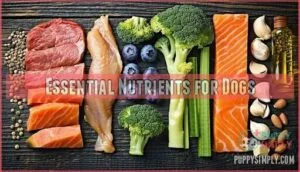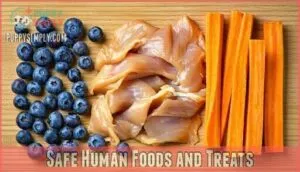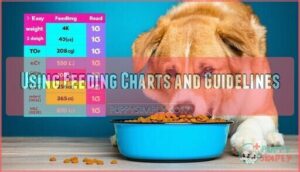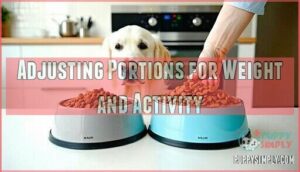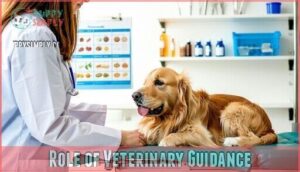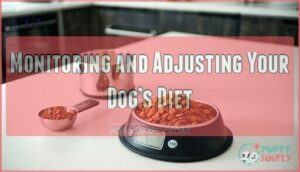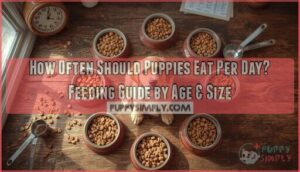This site is supported by our readers. We may earn a commission, at no cost to you, if you purchase through links.
 Learning how to feed your dog properly isn’t complicated, but it’s vital for their health. Feed adult dogs twice daily, spacing meals 8-12 hours apart to support their natural digestive rhythm. Puppies need more frequent feeding – four times daily until 12 weeks, then three times until six months. Stick to consistent meal times; your dog’s internal clock will thank you, and house training becomes easier.
Learning how to feed your dog properly isn’t complicated, but it’s vital for their health. Feed adult dogs twice daily, spacing meals 8-12 hours apart to support their natural digestive rhythm. Puppies need more frequent feeding – four times daily until 12 weeks, then three times until six months. Stick to consistent meal times; your dog’s internal clock will thank you, and house training becomes easier.
Choose quality food with meat as the first ingredient, and always provide fresh water. Monitor your dog’s body condition rather than just weight – you should feel their ribs without pressing hard. The secrets to portion control and reading your dog’s unique needs reveal even more feeding insights.
Table Of Contents
- Key Takeaways
- How Often Should You Feed Your Dog?
- What Should a Balanced Dog Diet Include?
- Choosing The Right Feeding Method
- Determining Proper Food Portions
- Monitoring and Adjusting Your Dog’s Diet
- Frequently Asked Questions (FAQs)
- Can I feed my dog table scraps or human food?
- How do I determine the appropriate portion size for my dog?
- Should I be concerned if my dog always appears hungry?
- What should I do if my dog refuses to eat their food?
- Are there any foods that are toxic or harmful to dogs that I should avoid feeding them?
- Can dogs eat raw meat safely?
- How to transition between different dog foods?
- Should pregnant dogs eat special diets?
- What causes food allergies in dogs?
- How does age affect nutritional needs?
- Conclusion
Key Takeaways
- Feed adult dogs twice daily – Space meals 8-12 hours apart to support natural digestion and prevent behavioral issues. Puppies need more frequent feeding until they reach six months old.
- Choose quality food with meat as the first ingredient – Focus on high-quality protein sources and always provide fresh water. Proper nutrition directly impacts your dog’s energy levels and overall health.
- Monitor your dog’s body condition regularly – You should be able to feel their ribs without pressing hard. Watch for changes in appetite or eating habits that might signal health issues.
- Use portion control based on ideal weight – Don’t rely solely on feeding charts. Consult your vet to determine the right amount based on your dog’s specific needs, activity level, and life stage.
How Often Should You Feed Your Dog?
You’ll find that most adult dogs thrive on two meals per day, spaced 8-12 hours apart, which aligns with their natural digestive cycle and prevents the dreaded "hangry dog" syndrome.
Establishing a consistent feeding schedule not only aids your dog’s physical health but also provides the security and routine that makes house training easier and helps you spot potential health issues early.
Puppy Feeding Schedules
Young puppies need frequent meals to fuel their rapid development. The weaning process begins around 4 weeks, switching from mother’s milk to solid food. Growth spurts demand consistent nutrition, while breed differences affect feeding schedules.
- 8-12 weeks: Feed 4 times daily during teething troubles
- 3-6 months: Reduce to 3 meals as potty training improves
- 6+ months: Shift to twice daily feeding schedule
Use a puppy feeding chart to determine proper feeding amounts for best growth.
Adult and Senior Dog Meal Frequency
Adult dog feeding schedules work best with twice-daily meals, spaced 8-12 hours apart. Your dog’s activity level and breed considerations influence meal frequency – active working dogs might need three meals, while less active seniors do well with two smaller portions.
Senior dogs benefit from mealtime consistency but may need age-based adjustments for health conditions.
Importance of Consistent Feeding Routines
Establishing a consistent feeding routine transforms your dog’s daily experience, offering considerable behavioral benefits and improved digestive health. Regular feeding times create predictable potty schedules, making house training simple.
This structured approach makes it easier to switch between foods while supporting effective appetite monitoring. When meal frequency remains constant, your dog’s body naturally gets used to these feeding methods, promoting great health and reducing anxiety-related behaviors.
What Should a Balanced Dog Diet Include?
Your dog’s nutritional needs aren’t as complicated as you might think, but getting the balance right makes all the difference in their health and energy levels. A complete canine diet requires six essential components: high-quality protein for muscle maintenance, healthy fats for coat shine and brain function, carbohydrates for energy, vitamins and minerals for immune support, and fresh water available at all times.
A complete canine diet requires six essential components: high-quality protein, healthy fats, carbohydrates, vitamins, minerals, and fresh water
Essential Nutrients for Dogs
Your dog’s nutritional needs center on six key components that fuel their body like premium gas in a car. Understanding these building blocks helps you make informed decisions about dog nutrition and quality animal nutrition.
- Protein Sources – Dogs need ten amino acids from animal-derived proteins for muscle development and repair
- Fat Importance – Omega fatty acids support skin health and provide concentrated energy for daily activities
- Carbohydrate Types – Energy sources that aid digestion and support gut health in active dogs
- Vitamin Needs – Fat-soluble vitamins A, D, E, K plus B-complex support immune function and growth
Safe Human Foods and Treats
Choosing safe treats for your dog’s daily diet requires careful consideration. While homemade dog treats offer control over ingredients, many safe treat alternatives exist commercially. Watch for food allergy symptoms when introducing new options.
| Safe Options | Toxic Human Foods | Nutritional Treat Benefits |
|---|---|---|
| Plain chicken | Chocolate, grapes | High-quality protein source |
| Carrots, apples | Onions, garlic | Essential vitamins, fiber |
| Blueberries | Xylitol products | Antioxidants for immune health |
| Sweet potatoes | Macadamia nuts | Beta-carotene, potassium |
Remember: treats shouldn’t exceed 10% of your dog’s total caloric intake to maintain proper dog nutrition balance.
Importance of Fresh Water
Beyond nutrition, fresh water stands as your dog’s most critical daily need. Dehydration risks become serious when dogs lose just 10% of body water, making consistent hydration signs monitoring essential.
Activity levels and health conditions affect your dog’s water requirements, so provide clean water sources throughout your home. Remember, water intake directly impacts your dogs daily diet effectiveness and overall dog health.
Choosing The Right Feeding Method
You’ll need to choose a feeding method that works best for your dog’s eating habits and your lifestyle. Whether you select portion control for dogs that overeat, free-choice feeding for grazers, or timed feeding for structured routines, the right approach helps maintain your dog’s health and prevents obesity-related complications.
Portion Control Method
For dogs who’d eat until they burst, portion control method becomes your best friend. You’ll determine your dog’s ideal body weight through veterinary assessment, then calculate precise feeding amounts.
Split daily portions into twice-daily feeding sessions, maintaining consistent intake. This approach prevents overeating while ensuring your dog’s daily diet meets nutritional needs without excess calories.
Free-Choice Feeding
Leave food constantly available? That’s the freechoice feeding method, but it’s risky business. This dog feeding approach leads to obesity risks when dogs overeat, and dog food can attract pests if not managed properly.
- Food freshness becomes an issue when kibble sits out for hours
- Monitoring intake gets nearly impossible with constant access
- Multiple pets may compete or one dog dominates the bowl
- Hygiene concerns arise from stale food and bacterial growth
- Free choice removes your control over portion sizes completely
Timed Feeding Method
Timed feeding transforms chaotic mealtimes into structured routines. You’ll place food down for 15-30 minutes, then remove it regardless of consumption. This feeding method promotes Appetite Regulation and creates Predictable Elimination patterns. Your dog learns that meal opportunities have limits, encouraging focused eating and improving Digestion Efficiency while providing clear Scheduled Meal Benefits.
| Time Period | Feeding Duration | Expected Behavioral Impact |
|---|---|---|
| Morning | 20-30 minutes | Establishes routine, reduces anxiety |
| Midday | 15-20 minutes | Maintains energy levels consistently |
| Evening | 20-30 minutes | Promotes better sleep patterns |
| Training | 10-15 minutes | Increases food motivation rewards |
| shift | 5-10 minutes | Builds discipline and focus |
Determining Proper Food Portions
You can’t just eyeball your dog’s dinner portions and hope for the best, since proper portion control directly affects their weight and overall health.
Your veterinarian can help calculate the exact amount your dog needs based on their ideal weight, age, and activity level, which may differ a lot from the feeding chart recommendations on commercial dog food packages.
Using Feeding Charts and Guidelines
Most feeding charts base portions on your dog’s current weight, but you’ll need to keep in mind their ideal weight instead. A thirty-pound dog generally needs 1¾ cups daily, while fifty-pound breeds require 2⅔ cups.
Chart interpretation becomes key since calorie density varies between food types and brands, affecting the feeding amount your pet actually needs.
Adjusting Portions for Weight and Activity
Your dog’s ideal weight and activity level significantly affect feeding amounts. Active dogs need 25-30% more calories than sedentary ones. Weight management goals require portion adjustments over a timeline of 2-4 weeks for safe changes. Age-related changes and breed-specific needs also influence dog feeding requirements.
- Activity Level Impact: Working dogs may need up to 6x resting energy requirements compared to sedentary pets
- Weight Management Goals: Adjust portions by 5-10% increments, monitoring weekly for safe weight changes
- Breed-Specific Needs: Large breeds need similar percentages but greater absolute quantities than smaller dogs
- Age-Related Changes: Senior and neutered dogs usually require 10-20% fewer calories than intact adults
Role of Veterinary Guidance
Schedule veterinary appointments to establish your dog’s ideal weight and receive dietary recommendations made just for you. Your veterinarian assesses breed predispositions, health conditions, and medical status to create weight management plans designed for your pet. They’ll provide supplement advice and adjust portions based on your dog’s health status, making sure they get the best nutrition throughout life stages.
| Health Factor | Veterinary Assessment | Feeding Impact |
|---|---|---|
| Breed Size | Growth rate evaluation | Portion timing adjustments |
| Medical Conditions | Disease-specific needs | Therapeutic diet requirements |
| Activity Level | Energy expenditure analysis | Caloric intake modifications |
| Age Stage | Life phase nutritional needs | Formula type recommendations |
| Body Condition | Weight status examination | Portion size calibrations |
Monitoring and Adjusting Your Dog’s Diet
You’ll need to watch your dog’s eating habits and body condition regularly, as changes in appetite often signal health issues before other symptoms appear.
Adjusting food portions, switching brands, or modifying feeding schedules becomes necessary when your pup’s weight, activity level, or life stage changes.
Recognizing Changes in Appetite or Health
Your dog’s health status speaks volumes through subtle changes you might miss. Watch for these red flags that warrant a veterinary appointment:
- Appetite loss lasting over 48 hours or sudden weight fluctuations
- Energy levels dropping a lot with coat condition deteriorating
- Stool changes in consistency, color, or frequency
These shifts often signal an underlying medical condition before obvious symptoms appear. Trust your instincts about your dog’s eating habits.
Treats in Moderation and Training Rewards
Your dog’s treat calorie limits shouldn’t exceed 10% of daily intake. Smart training treat types include small, soft pieces that won’t disrupt dog feeding schedules. Healthy treat options like carrots provide dental treat benefits while managing dog weight. Treat timing matters – use rewards during training sessions, not meals.
| Treat Type | Daily Limit |
|---|---|
| Training treats | 5% calories |
| Dental chews | 2-3% calories |
| Fruit/veggie | 2% calories |
| Commercial treats | 3% calories |
| High-value rewards | 1% calories |
Dealing With Picky Eaters or Grazers
When your dog becomes a finicky eater, don’t panic. Food aversion causes range from medical issues to behavioral quirks.
Enticing picky eaters requires patience and creativity—try warming food or adding small amounts of low-sodium broth.
Grazing dangers include overeating and food spoilage, so avoid free-feeding.
Consider supplementing diet only after veterinary consult to rule out underlying health problems affecting feeding habits and food intake.
Frequently Asked Questions (FAQs)
Can I feed my dog table scraps or human food?
You can share table scraps with your dog, but keep them under 10% of daily calories. Safe options include chicken, beef, rice, carrots, and blueberries.
Avoid toxic foods and always prioritize balanced nutrition.
How do I determine the appropriate portion size for my dog?
Many believe "one-size-fits-all" feeding works, but your dog’s weight determines ideal portions. Adult dogs need consistent nutrition based on their specific weight requirements. Check your vet for guidance, then split daily amounts across meals.
Should I be concerned if my dog always appears hungry?
It’s normal for dogs to act hungry – they’re opportunistic eaters by nature. However, if you’re feeding appropriate portions and your dog seems constantly ravenous, consult your veterinarian to rule out underlying health issues.
What should I do if my dog refuses to eat their food?
First, rule out medical issues by consulting your vet if the behavior persists.
Try warming the food slightly, switching brands gradually, or adding a small amount of low-sodium broth to make it more appealing.
Are there any foods that are toxic or harmful to dogs that I should avoid feeding them?
Yes, several foods can poison your dog. Chocolate, grapes, raisins, onions, garlic, and xylitol (artificial sweetener) are dangerous. Avocado, macadamia nuts, and alcohol should also be avoided completely.
Can dogs eat raw meat safely?
Raw meat poses serious bacterial risks to you and your pup. It can carry harmful bacteria and parasites that can make dogs (and humans) sick.
Nearly 25% of raw food samples test positive for harmful bacteria. Choose cooked meat instead.
How to transition between different dog foods?
About 25% of dogs experience digestive upset during food transitions. You’ll want to gradually mix increasing amounts of new food with decreasing amounts of old food over 7-10 days.
This slow approach prevents stomach issues.
Should pregnant dogs eat special diets?
Expecting mothers need enhanced nutrition to support growing puppies. Pregnant dogs have increased energy and nutrient requirements, requiring 25% to 50% more than their normal food intake by the end of pregnancy.
To meet these needs, consider that caloric intake increases a lot during late pregnancy. Switch to puppy or reproduction formula for great health.
What causes food allergies in dogs?
Food allergies happen when your dog’s immune system overreacts to specific proteins—most commonly chicken, beef, dairy, or wheat. Their body mistakenly treats these safe ingredients as threats, triggering uncomfortable reactions that can worsen with repeated exposure.
How does age affect nutritional needs?
Your dog’s age dramatically changes their nutritional requirements. Puppies need calorie-dense food for rapid growth, while senior dogs require fewer calories but more joint-supporting nutrients to maintain health.
Conclusion
Remember that proper nutrition, consistent schedules, and careful monitoring form the foundation of canine health. Master these fundamentals, stay observant of your dog’s changing needs, and maintain regular veterinary consultations.
Learning how to feed your dog correctly requires patience and attention to detail, but the rewards include improved energy, better digestion, and a longer lifespan. Your commitment to these feeding principles will strengthen the bond with your companion while supporting their overall well-being for years to come.

